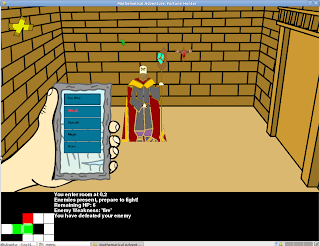Chapter 6 of the Teaching Open Source book is called "Debugging_the_Code". The first couple sections of this chapter are about find the bug tracker for your open source project. The author defines certain words that you need to know and that should be used in the bug tracker so that the bugs are clearly define and there is enough information for developers to find the bug, reproduce the error, and determine the level of importance of the bug.
Exercise 6.4
This exercise is to find the oldest open bug for the project that I have chosen, Fortune Hunter. There are currently only two open bugs for this project and the oldest one is actually the one we chose to help fix for our assignment due on Thursday.
The name of this bug is "scan damage". The reason why it is a bug is because the "scan" button in the game should only display the weakness of the enemy, not proceed to attack the enemy, which is what it currently does. The priority is marked as "major" and there is no severity listed. However, the author said that normally most projects will pick one of the two instead of having both.
I think the bug hasn't been fixed yet because there aren't that many people to fix bugs. I was looking through the bug tracker, opening all the bugs/tasks/enhancements and 98% of them have been reported by the main developer, Jonathan Meschino. I see only two other people listed as owners of some of the tasks/enhancements. Therefore, this is why I think this bugs has not been fixed. I don't think that Jonathan can't fix the bug, just that he hasn't had time to even look at this bug.
Exercise 6.5
This exercise is to create an account to gain access to the bug tracker. Jonathan has been very enthusiastic about us helping/contributing so he responds to all of our emails. He is so helpful and even told us how to set up our accounts. Brittany has been emailing back and forth with Jonathan about setting up our accounts for the bug tracker. He said he was still working on it yesterday, so we're just waiting to hear from him.
Exercise 6.6
The next exercise is to reproduce the bug from the bug tracker. I have been able to reproduce it before so this time I'll try to explain the steps for reproducing it.
1) Open the terminal
2) cd into "csci462/fortunehunter/MAFH2"
2) Type the command "python MafhActivity.py"
3) Press the Enter key to select "Adventure Play" (since there is no pointer in the game).
4) Press the Enter key to select "New Game"
5) Type in a name and press the Enter key
6) Arrow up key twice
7) Arrow right
8) Arrow up
9) Arrow left
10) Arrow up twice (you have reached an enemy and the options menu appears)
11) Arrow up once so that the 'scan' option is highlighted and press the Enter key.
"You attack for 10 damage" appears instead of a weakness level.
I'm pretty sure the enemies appear in different rooms each game so this probably wouldn't be the process to reproduce the error again but the error occurs every time you reach an enemy. Its hard to tell where you are going in the game because the map part of the screen is below my actual screen so I can't see it. Its hard to tell if I really did arrow up and left to get through the door or not.
I tried to look through the python files to see where is bug is occurring. I think I have found where it states what it should display but I'm not sure when/where is producing the wrong output. I haven't figured out how to debug in Netbeans yet, which I think it what I'll need to do to figure out the error.
Exercise 6.7
This exercise is to triage five bugs. Currently, there are only 2 bugs in our project's bug tracker. I think the one my group has chosen to focus on, scan damage, is reported fairly well. It has a reporter, priority level, component, milestone, and version. The description of the bug is given and understandable but it probably could have listed what the button displays as well as what it does. It could probably also list an example of what it should have displayed if it were working properly. There are not any steps on how to reproduce the error or where in the code this button was created/functioning. I think the "MAFH" component is just a folder that has many more files within it.
This information goes the same for the second bug reported about this activity. The only difference is that the priority level is "critical" instead of "major". The description is that the player is unable to move through the doors after they enter dungeon 3. The doors might be locked but there is no messages stating that the user needs a key. I wouldn't know where to begin with this bug because I don't even know what dungeon 3 is. I'm not sure if its referring to a room or a level or something else. I also do not know how the keys are used in the game to unlock doors. This bug could use a lot more information to clarify the whats wrong and where the bug is occurring.
